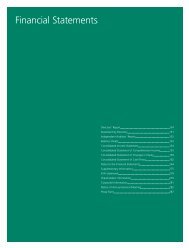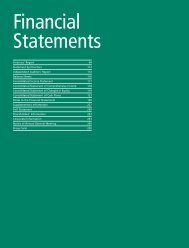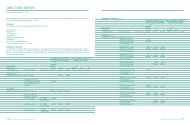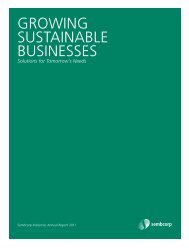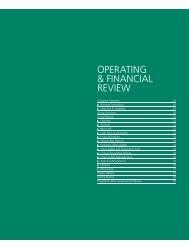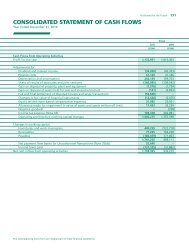FINANCIAL STATEMENTS (Full Version) - Sembcorp
FINANCIAL STATEMENTS (Full Version) - Sembcorp
FINANCIAL STATEMENTS (Full Version) - Sembcorp
You also want an ePaper? Increase the reach of your titles
YUMPU automatically turns print PDFs into web optimized ePapers that Google loves.
Notes to the<br />
Financial Statements<br />
Year Ended December 31, 2008<br />
2. SUMMARY OF SIGNIFICANT ACCOUNTING POLICIES (cont’d)<br />
r. Provisions<br />
A provision is recognised in the balance sheet when there is a legal or constructive obligation as a result of a past<br />
event, the obligation can be reliably estimated and it is probable that an outflow of economic benefits will be<br />
required to settle the obligation. If the effect is material, provisions are determined by discounting the expected<br />
future cash flows at a pre-tax rate that reflects current market assessments of the time value of money and, where<br />
appropriate, the risks specific to the liability.<br />
s. Income Tax Expense<br />
Income tax expense comprises current and deferred tax. Income tax expense is recognised in the income statement<br />
except to the extent that it relates to items recognised directly in equity, in which case it is recognised in equity.<br />
Current tax is the expected tax payable on the taxable income for the year, using tax rates enacted or substantively<br />
enacted at the reporting date, and any adjustment to tax payable in respect of previous years.<br />
Deferred tax is recognised using the balance sheet method, providing for temporary differences between the<br />
carrying amounts of assets and liabilities for financial reporting purposes and the amounts used for taxation<br />
purposes. Deferred tax is not recognised for the following temporary differences: the initial recognition of<br />
goodwill, the initial recognition of assets or liabilities in a transaction that is not a business combination and that<br />
affects neither accounting nor taxable profit, and differences relating to investments in subsidiaries and joint<br />
ventures to the extent that they probably will not reverse in the foreseeable future. Deferred tax is measured at<br />
the tax rates that are expected to be applied to the temporary differences when they reverse, based on the laws<br />
that have been enacted or substantively enacted by the reporting date. Deferred tax assets and liabilities are<br />
offset if there is a legally enforceable right to offset current tax liabilities and assets and they relate to income<br />
taxes levied by the same tax authority on the same taxable entity, or on different tax entities, but they intend to<br />
settle current tax liabilities and assets on a net basis or their tax assets and liabilities will be realised simultaneously.<br />
A deferred tax asset is recognised to the extent that it is probable that future taxable profits will be available<br />
against which temporary differences can be utilised. Deferred tax assets are reviewed at each reporting date and<br />
are reduced to the extent that it is no longer probable that the related tax benefit will be realised.<br />
t. Share Capital<br />
Ordinary shares are classified as equity.<br />
Incremental costs directly attributable to the issuance of new ordinary shares and share options are deducted<br />
against the share capital account.<br />
Where the Company’s ordinary shares are repurchased (treasury shares), the consideration paid, excluding any<br />
directly attributable incremental costs, is deducted from equity attributable to the Company’s equity holders and<br />
presented as “reserve for own shares” within equity, until they are cancelled, sold or reissued.<br />
When treasury shares are cancelled, the cost of treasury shares is deducted against the share capital account, if<br />
the shares are purchased out of capital of the Company, or against the accumulated profits of the Company, if the<br />
shares are purchased out of profits of the Company.<br />
When treasury shares are subsequently sold or reissued pursuant to the Share-based Incentive Plans, the cost of the<br />
treasury shares is reversed from the reserve for own shares account and the realised gain or loss on sale or reissue,<br />
net of any directly attributable incremental transaction costs and related income tax, is recognised as a change in<br />
equity of the Company. No gain or loss is recognised in the income statement.<br />
2. SUMMARY OF SIGNIFICANT ACCOUNTING POLICIES (cont’d)<br />
u. Dividend<br />
Dividends on redeemable convertible preference share capital are recognised as a liability on an accrual basis.<br />
Other dividends are recognised as a liability in the period in which they are declared.<br />
Dividends on redeemable convertible preference share capital classified as a liability are accounted for as finance<br />
costs. Dividends on ordinary shares and redeemable convertible preference share capital classified as equity are<br />
accounted for as movements in revenue reserve.<br />
v. Revenue Recognition<br />
i. Income on Goods Sold and Services Rendered<br />
Revenue on goods sold is recognised when the significant risks and rewards of ownership have been<br />
transferred to the buyer. Revenue from the provision of consultancy services is recognised using the percentage<br />
of completion method. The percentage of completion is measured by reference to the percentage of cost<br />
incurred to-date to the estimated total costs for each project. Revenue on other service work is recognised<br />
when the work is completed. Revenue excludes goods and services or other sales taxes and is after deduction<br />
of any trade discounts. No revenue is recognised if there are significant uncertainties regarding recovery of the<br />
consideration due, associated costs or the possible return of goods.<br />
ii.<br />
Contract Revenue<br />
Revenue from repair work, engineering, overhaul, service work and marine and civil construction contracts<br />
is recognised based on percentage of completion. The percentage of completion is assessed by reference to<br />
surveys of work performed, or by reference to the ratio of costs incurred to-date to the estimated total costs for<br />
each contract, with due consideration given to the inclusion of only those costs that reflect work performed.<br />
When the outcome of a long-term contract can be estimated reliably, contract revenue and costs are recognised<br />
as income and expense respectively using the percentage of completion method. When the outcome of a longterm<br />
contract cannot be estimated reliably, revenue is recognised only to the extent of contract costs incurred<br />
that can probably be recovered and contract costs are recognised as an expense in the period in which they<br />
are incurred.<br />
iii. Sale of Electricity and Gases<br />
Revenue from the sale of electricity, utilities and gases is measured at the fair value of the consideration received<br />
or receivable, net of returns and allowances, trade discounts and volume rebates. Revenue is recognised when<br />
electricity, utilities and gases are delivered at the customers’ premises which is taken to be the point of time<br />
when the customer has accepted the deliveries and the related risks and rewards of ownership and based on<br />
contractual terms stipulated in respective agreements with customers.<br />
iv. Service Concession Arrangement<br />
Revenue relating to construction services under a service concession arrangement is recognised based on the<br />
stage of completion of the work performed, consistent with the Group’s accounting policy on recognising<br />
revenue on construction contracts. Operation or service revenue is recognised in the period in which the services<br />
are provided by the Group. When the Group provides more than one service in a service concession arrangement,<br />
the consideration received is allocated by reference to the relative fair values of the services delivered.<br />
Infrastructure constructed under a service concession arrangement is not recognised as property, plant and<br />
equipment of the Group.<br />
Preference shares are classified as equity if it is non-redeemable. Preference shares are classified as a liability if they<br />
are redeemable on a specific date or at the option of the shareholders.<br />
134 Delivering Essential Solutions <strong>Sembcorp</strong> Industries Annual Report 2008 135




